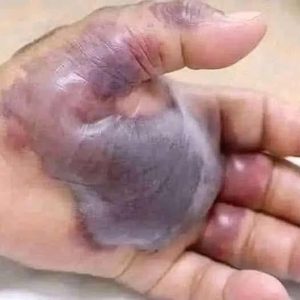According to initial reports, the recent incident involving a teenage girl has raised serious concerns among medical professionals, parents, and educators alike. The teenager had been alone in her room when the event occurred, and while the exact motivations remain unclear, experts suggest that factors such as curiosity, misinformation, or a lack of proper sexual education may have contributed. Unfortunately, the consequences were far more severe than she ever anticipated, underscoring the dangers of experimenting with foreign objects in the body.
The object involved—a pen—caused significant internal lacerations and tissue damage, leading to immediate and potentially life-threatening complications. The teenager experienced severe bleeding, intense pain, and a heightened risk of infection. Recognizing the urgency of the situation, her caregivers acted quickly, and she was transported to a hospital where a team of medical professionals performed an emergency procedure to remove the object. The surgical intervention was crucial not only to stabilize her condition but also to prevent further damage to sensitive internal organs.
Medical staff emphasized that the situation could have easily resulted in long-term or permanent injury. Damage to the reproductive system is particularly concerning because even minor trauma can have lasting consequences, including chronic pain, scarring, and complications that may affect future fertility. Beyond physical harm, incidents like this also carry a profound psychological impact, leaving lasting emotional distress and anxiety. Had the teenager not received timely medical attention, the situation could have escalated into life-threatening complications such as sepsis or severe internal infection, and in extreme cases, death.
Experts note that the incident reflects a broader issue regarding adolescent sexual curiosity and the critical importance of accurate, comprehensive sexual education. Curiosity about one’s body and sexual development is natural during the teenage years, but many young people do not have access to reliable guidance. Misinformation obtained from the internet, peers, or popular media can lead to risky behaviors that have serious health consequences. In this case, the teenager’s actions, though likely driven by natural curiosity, had dangerous outcomes. Healthcare professionals strongly emphasize that inserting foreign objects into the body is never safe, and can result in permanent damage, infection, or even fatal outcomes.
The delicate tissues of the genital and reproductive systems are particularly vulnerable. Unlike other parts of the body, these tissues can be easily damaged, and even small injuries may escalate quickly if bacteria enter the body or if proper medical care is not sought immediately. Emergency interventions often require surgical procedures to prevent further complications, and recovery may involve ongoing medical care, including antibiotics, follow-up examinations, and counseling for psychological trauma. The long-term consequences may include chronic pain, emotional distress, and in some cases, irreversible damage to reproductive organs.
Medical professionals and sexual health educators stress the importance of fostering open communication between adolescents and trusted adults. Parents, caregivers, and educators should encourage teenagers to ask questions about their bodies and sexual development in safe, judgment-free environments. By providing clear, factual information, adults can help young people make informed choices that protect both their physical and emotional health. Conversations about boundaries, consent, and safe practices are essential to reducing the likelihood of accidents or injuries related to sexual exploration.
This incident also highlights the need for accessible sexual health resources, including educational programs in schools, community centers, and online platforms that provide medically accurate guidance. Teenagers should be informed about the risks associated with inserting foreign objects, as well as alternative ways to explore their bodies safely and responsibly. Sexual education should include practical advice on hygiene, the potential dangers of experimentation, and clear instructions on when to seek medical help in emergencies. Adolescents must understand that curiosity should never come at the cost of safety, and that immediate medical attention is crucial if an accident occurs.
In addition to formal education, parents and guardians play a pivotal role in shaping safe behaviors. Encouraging open dialogue about sexual health, anatomy, and safe exploration can help reduce the stigma surrounding these topics. Teens often refrain from discussing concerns for fear of judgment or punishment, which can lead to unsafe experimentation and hidden injuries. By creating a supportive environment, caregivers can empower young people to seek guidance before attempting potentially dangerous actions.
Healthcare providers also emphasize the psychological component of such incidents. Adolescents who experience trauma, fear, or misinformation may engage in risky behaviors as a form of coping or experimentation. Counseling and emotional support are often necessary to help teenagers process their experiences and develop healthy attitudes toward their bodies. Psychological support can also help mitigate feelings of shame or guilt, which may otherwise discourage teens from seeking medical care when they encounter future issues.
Preventative measures are equally important. Teens should be advised to avoid inserting any non-medical objects into their bodies, and instead, use medically approved products or seek guidance from healthcare professionals if curiosity arises. Awareness campaigns that highlight real-world consequences, such as injury and infection, can also play a role in educating young people about the risks of unsafe sexual practices. Parents, educators, and community organizations must work together to ensure that accurate, age-appropriate information reaches adolescents in a timely and engaging manner.
Ultimately, this case serves as a sobering reminder of the serious consequences that can result from a single moment of curiosity. While adolescent exploration is a natural part of development, certain behaviors can have irreversible physical and emotional outcomes. Prompt medical care, comprehensive sexual education, and a supportive environment are critical tools in preventing emergencies like this from occurring. By fostering knowledge, awareness, and open communication, we can help teens navigate their development safely and confidently.
Medical professionals urge all parents and caregivers to take this opportunity to speak openly with their children about sexual health, the risks of experimentation, and the importance of seeking help immediately when accidents occur. In doing so, they can prevent not only physical injuries but also the emotional and psychological trauma that often accompanies such incidents. Every teenager deserves access to accurate information, safe guidance, and the reassurance that their curiosity can be explored responsibly without risking permanent harm.
In conclusion, this incident underscores the vital need for education, awareness, and vigilance in adolescent sexual health. The teenager involved was fortunate to receive immediate medical attention, but the risks associated with such behavior are real and potentially life-threatening. Healthcare providers and educators continue to stress that inserting non-medical objects into the body is never safe, and that preventative education and open communication are essential to protecting the physical and emotional well-being of young people. Through these efforts, similar tragedies can be avoided, and adolescents can grow into informed, confident individuals capable of making safe and responsible choices regarding their bodies.





